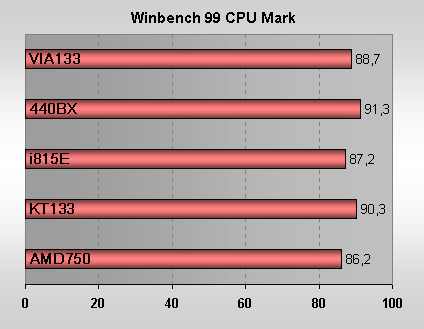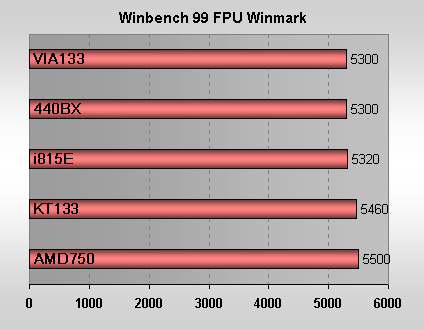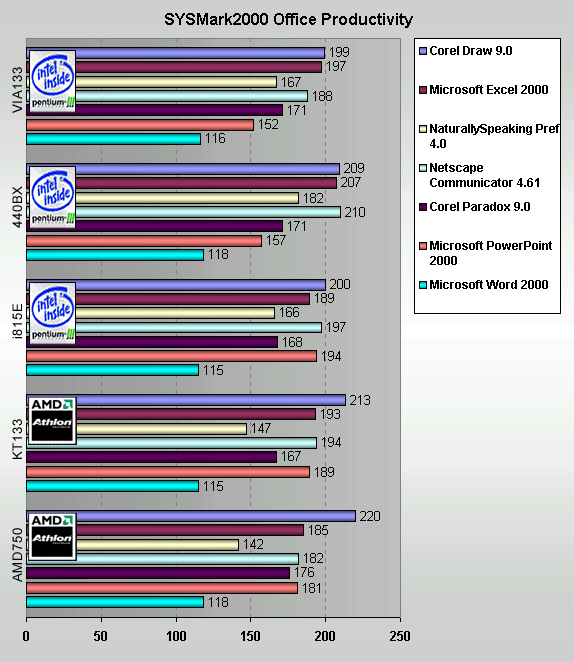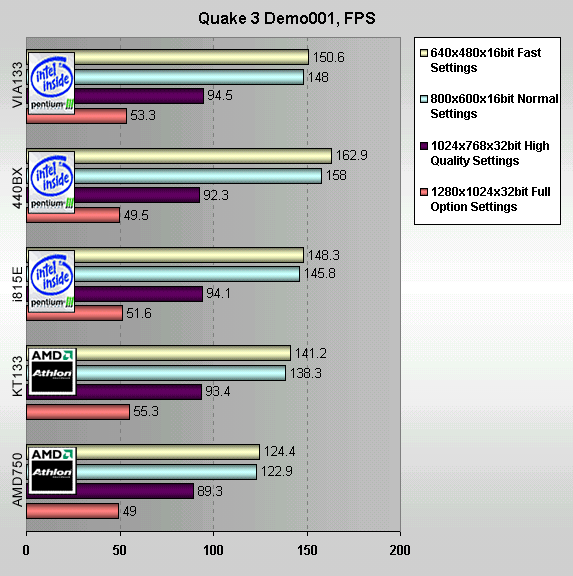 |
||
|
||
| ||
I promise I'll try to pay less attention to pure technical terms and characteristics which are known to every student, and turn directly to comparison of processors and platforms for them. Today we can see much more widespread acceptance of GHz processors. The maximum attainable processor frequency which are based on 0.18 micron technology is a little higher than 1 GHz, so in result not all grown crystals pass the tests and can be proud of the marking 1000+ MHz. We don't know the exact percentage, but the price proves the rarity of them. Some processors are lucky to serve as a base for several platforms. For example, Thunderbird from AMD are installed in AMD750 and VIA KT133, and Coppermine from Intel are even on three platforms - Intel 440BX, VIA ApolloPro 133A and Intel 815. And they are lucky, because quite old 750 and BX are still mighty, despite the obsolescent AGP 2x, and new comers KT133 and i815 got stronger having improved BIOS and drivers. But, it becomes quite difficult to define a performance leader. Moreover, two chipsets from VIA for Intel and AMD processors, which have similar architecture but differ in the mechanism of interaction of the north bridge with a processor, can define the relative performance of the competitors quite exactly. OK, let's turn to the list of our contestants. HardwareThe table is made the following way - many well-known facts are described briefly, and a close attention was paid to different interesting practical issues. At first looks, AMD appears a leader, but there is some factors which don't allow it to be first. Let's suggest a relative performance of the processors, and then we will see whether the theory overlaps with the practice. Considering a big size of L2-cache and more effective exclusive scheme (when the contents of L1 don't double in L2-cache), T-Bird is evidently offers a bigger total cache volume - and the performance is likely to be higher. But Intel Coppermine processors turned to be much faster than Katmai because of 2 reasons. First, L2 cache works at the processor's frequency. Second, the main, is that Intel uses a revolutionary 256-bit bus with Advanced Transfer Cache Architecture between a processor and an external L2cache instead of 64-bit bus. This goody was achieved thanks to L2 cache integration into the chip, otherwise (with an external cache) it would have caused an increase in the number of processor's outputs at 256-64=196, and 4 times more cache chips, but it's beyond a manufacturer's strength. Intel managed to smooth out the bottlenecks limiting the system performance. But let's return to the question at hand. As for T-Bird, it remains with the same 64-bit bus though with a larger L2 cache. That's why it hasn't got any advantages. Let's consider the bus of address and data of the both processors - EV-6 competes against AGTL+, a weaker contester from Intel. However, at the RAM frequency less than 133 MHz, EV-6 gets no advantages over its rival. Moreover, EV-6 refuses to work at irregular frequencies (what makes impossible changing FSB frequency). Intel processor is much simpler due to the smaller size of caches. It contains only 28 million transistors against 37 of T-Bird. It consumes less power and dissipated less heat. But T-Bird allows higher junction temperature, it can work at higher temperatures without detriment to stability. But Coppermine works at 1 GHz and I'm sure nobody saw an aluminum T-Bird working at 1 GHz. However, our T-Bird works even at 1.2 GHz thanks to the copper conductors, and Intel withdrew 1,13 GHz processors. Less power consumption allowed Intel to win a hundred MHz, but AMD managed to increase the frequency by 400-500 MHz. And for T-Bird 1.2 GHz is not the upper limit. Coppermine won't be able anymore to rise the frequency, and it's not worth dreaming about overclocking. Moreover, it's aggravated by the fact that the appropriate chips are released rarely, and it doesn't allow decreasing the price. I'm not sure whether T-Bird is worth to overclock, but it's possible to add 50-100 MHz over. It will be exactly the price that will serve the governing factor for a leader. And further we will turn to the performance difference of the processors. The springboards which rise processors to the performance top are chipsets. Let's see how good they are. Here are the competitors:
First, we'll talk about north bridges. Synchronous chipsets of the previous generation 440BX and AMD750 on the one hand can't set the processor and the memory to different frequencies, but on the other hand they work faster because there are no extra delays which are brought in with the asynchronism. Besides, the old fellow from Intel is preferable as for the work at 133 MHz. The limitation concerns only two AGP divisors (1/1 and 3/2), it means that we can easily get the necessary 2/1 to reach 133/2 = 66 MHz on AGP. Nevertheless, the most advanced users utilize BX in their systems exactly at this frequency, since 89 MHz on AGP both doesn't hamper a stable work, and allows to consider AGP working speed close to 3x. Although with the exceeding 133 MHz of the bus it's the cutoff on AGP that stimulates an unstability, on the other hand the boards based on this chipset are ideal alternative for overclockers with 66 or 100 bus. AMD-751 is, unfortunately, an obvious outsider because it can't work with the memory at 133 MHz. Well, it's undoubtedly the lack of AGP 4x that doesn't allow these chipsets to compete equally against their competitors, and in the modern games at 1024 resolution on 768 and higher AGP appeared a major bottleneck. So, they may succeed only in non-game applications. New asynchronous chipsets offer high possibility when using different memory and processor frequencies, but this can't help effecting performance. In this case, the chipsets from VIA are the most flexible. Let's see what are the possibilities of setting of memory frequency depending on the FSB frequency for VIA Apollo Pro133A.
The preferable variant is usage of the memory at FSB+33 MHz, what allows huge performance gain even comparing with a synchronous BX with the memory at FSB frequency. In this case, the major drawback of VIA chipsets is asynchronism. Here, i815 is close to BX and doesn't lower the speed too much when accessing the memory, though we are surprised at its possibility to use different frequencies of the memory and the FSB. It can't do the basic thing - work with the memory at 133 MHz, if there installed a processor with 100 MHz bus.
Another considerable drawback of the i815E north bridge is a small supported memory size. Besides, with 3 DIMM slots on the board, in most cases on 133 MHz only 2 are utilized in reality - with more than 4 slots the memory goes to 100 MHz, that is, the usage of 3 2-side PC133 DIMM modules with 128 MBytes simultaneously at 133 is impossible. However, ASUS in its CUSL2 solved the problem. One more limitation is lack of ECC support, what makes the chipset unsuitable for high-performance work stations. New chipsets with AGP 4x beat the other at high resolutions in game applications, though the asynchronism will prevent them to become pure leaders. Having the processor Coppermine with FSB 133 MHz we should notice, that in all used boards for the processor from Intel the memory worked at 133 MHz, on KT133 based board it also worked at 133 MHz, and only with AMD750 it was 100 MHz. OK, now we will pass over to the south bridges. I can't see evident drawbacks here, and everything that is absent can be replaced by external chips, such as an external IDE-controller or hardware monitoring. On the other hand, it makes the end products more expensive. And with the equal cost of chipsets with a full and a lighter south bridge the mainboards based on them with equal possibilities will cost too different. The oldest is the bridge of 440BX chipset created 2 years ago, it's the poorest one. VIA south bridge have a lot of features and can serve as an example. As for Intel, it excluded ISA support in its i815. This, however, isn't convenient for those users with ISA devices who want to make an upgrade. In the case of AMD we can use a more progressive chip from VIA as a south bridge. Note that all the mainboards were equipped with the latest BIOS versions. PerformanceA simultaneous estimation of all 5 systems allows to ascertain the contribution of a processor and a chipset to the performance. Here you can see a configuration of the testbed:
Software:
 We'll start with the following tests: Ziff-Davis Winbench 99 v1.1 CPUMark and Ziff-Davis Winbench 99 v1.1 FPU Winmark. The first of them - CPUMark - emulates an intensive work of the modern 32-bit office applications. i815 appeared not very good one, and BX became a leader. Though it's quite difficult to reveal a leader, and the loss of i815 might happen due to precision of measurements.  The second test - FPU Winmark - measures a "clear" performance of the coprocessors. In this case i815 performed much better serving as an accelerator of the coprocessor. It's obvious that Thunderbird's coprocessor is a bit more powerful, it won about 4%.  Office Productivity and Content Creation tests of the well-known test packet SysMark are used practically by every tester. Well, let's take a gander at the most important aspects here. First comes the chipsets. Overclocked by 33%, BX surpassed both VIA 133A, and i815 by a significant margin, it lost only in PowerPoint2000. By the way, it the only application, where i815 could take a leap forward. I think that it happened because it has (unlike its competitors) ATA100-controller, and when working with PowerPoint it had quite intensive disc access. Besides, the replacement the disc by Quantum Fireball CX 5400 rpm caused a magnificent performance decrease in Office Productivity test - from 3 to 15%, and in PowerPoint the decrease was maximum. VIA 133A performed quite good, sometimes it even outperformed i815 by a small margin. AMD750 surprised us greatly. It was the fastest in CorelDraw (mainly, a vectoring of raster images) and the fastest when working with the data base in Paradox, in spite of 100 MHz memory (it seems that the caches managed to accommodate everything, and the disc controller is not so bad). Now turn to the processors. In CorelDraw Thunderbird appeared the first (it confirmed high speed of their coprocessors), but in NaturallySpeaking program (stream speech recognition) it lost for lack of the bandwidth of the 64-bit bus of L2 cache. Besides, the fact, that the given application isn't optimized for 3D Now!, told upon the loss. So, the fast coprocessor couldn't help here. Well, however that may be, Coppermine is a winner.  Well, BX is again beyond all, and VIA133A and i815 keep up together. Then, KT133 and AMD750 show similar performance - the main load lies upon the processor's cache. As for the processor, their results are too different. Starting quite well, Thunderbird lagged behind in the end. In Bryce 4, which emulates 3D Studio, Athlon won thanks to its coprocessors, but in all other applications including the most popular one - Photoshop, it disappoint us. Coppermine surpassed the competitor by 25%. Although it's not thanks to Intel' merit and AMD's loss - it's all because of Adobe. It's already 2 years that this company couldn't optimize their products for the set 3D Now!.  Well, the game applications. At low resolutions the synchronous BX is again the first. VIA and i815 compete against each other as equals. On the other hand, can we see the difference between 160 and 150 fps by eye? And when passing to 1024 on 768 and higher with 32-bit color there appears the problem of usage of AGP. Moreover, the chipsets from VIA, especially KT133, performed brilliant, at high resolutions 1-2 fps over is a serious claim to become a leader. As for the processors, Coppermine looks preferable. And only at 1280 Thunderbird became a leader, though it's thanks to KT133 most likely. ConclusionTalking about who is the best is unnecessary, you can see it from the results. Here I want you to pay attention to a bit different things. For a long time AMD processor were beaten by Intel devices. And even when the leadership was possible, programmers of many companies didn't feel a desire to work hard with their products (Why optimizing programs for AMD with its a few percents of the market?). The company had to compete only decreasing the price. Besides, low-cost (and low-quality) boards became widespread, and this aggravated the situation as well. Yes, there were some good models, but the majority preferred i440BX based mainboard to ALi Aladin V at the same price. And the chipsets, which served a base for those boards, were being developed quite quickly. With the Athlon processors appear in the market everything turned up aces for AMD. So, Intel's domination has finished. Today, you can get the same or even higher performance (with a coprocessor) and save some money for extra memory or 3D accelerator of the next generation. Besides, today's processors have reached so high performance that it may be called for by just one of a hundred users. An ideal choice is the following: a cheap processor, a chipset with maximum possibilities and a motherboard from a respective manufacturer as the guarantee from failures. And still, in this honest struggle Intel has proved its might. And if you decided to go with a 1 GHz friend, the following table is right for you:
Write a comment below. No registration needed!
|
Platform · Video · Multimedia · Mobile · Other || About us & Privacy policy · Twitter · Facebook Copyright © Byrds Research & Publishing, Ltd., 1997–2011. All rights reserved. | ||||||||||||||||||||||||||||||||||||||||||||||||||||||||||||||||||||||||||||||||||||||||||||||||||||||||||||||||||||||||||||||||||||||||||||||||||||||||||||||||||